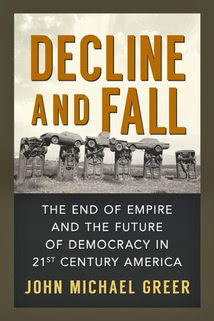To misuse a bit of prose from Charles Dickens, it was neither the best of times nor the worst of times, but I know very few people who will object when, a few hours from now, 2014 gets dragged off to the glue factory. This has not been a good year for most people in the United States. By all accounts, this year’s holiday season was an economic flop of considerable scale—the US media, which normally treats cheery corporate press releases with the same enforced credulity that Pravda
used to give to pronouncements from the Politburo in the Soviet era, has had to admit that Black Friday sales were down hard this year, even counting the internet—and plenty of Americans outside the echo chambers of the media have very good reasons to worry about what 2015 will bring.
Mind you, cheerleading of a distinctly Pravda-esque variety can still be heard from those pundits and politicians who are still convinced that people can be talked into ignoring their own experience if they can only be force-fed enough spin-doctored malarkey. That sort of enthusiasm for the glorious capitalist banker’s paradise has plenty of company just now; I’m thinking in particular of the steady drumbeat of articles and essays in the US mass media wondering aloud why so many Americans haven’t noticed the economic recovery of the last four years, and are still behaving as though there’s a recession on.
Of course there’s an explanation for that awkward fact, which is that the recovery in question never happened—outside, that is, of the abstract otherworld of numerical jugglery and spin doctoring that passes for official economic statistics these days. For most Americans, the last four years have been a bleak era of soaring expenses, shrinking incomes and benefits, rising economic insecurity, and increasingly frequent and bitter struggles with dysfunctional institutions that no longer bother even to pretend to serve the public good. That’s the reality people in the United States face when they get out of bed each morning, but it’s not a reality that’s welcome in the American mass media, so endless ingenuity has been expended in explaining why so many people in the US these days haven’t noticed the alleged economic recovery that’s allegedly burgeoning all around them.
I expect to see a good deal more of this sort of twaddle in the weeks immediately ahead, as those mass media pundits who haven’t yet trotted out their predictions for the new year get around to that annual task. For that matter, it’s doubtless safe to assume that out here on the fringes where archdruids lurk, there will be plenty of predictions of a different kind or, rather, several different kinds. There will be another round of claims that this is the year when the global economy will seize up suddenly and leave us all to starve in the dark; there will be another round of claims that this is the year when this or that or the other hot new technology will come swooping in to save the day and let the middle classes maintain their privileged lifestyles; there will be—well, those of my readers who have been following the blogosphere for any length of time can fill in the blanks themselves.
I’ve noted in previous years just how many of these latter predictions get rehashed every single January in the serene conviction that nobody will notice how often they’ve flopped before. Popular though that habit may be, it seems counterproductive to me, since—at least in theory—predictions of the sort we’re discussing is intended to be something more than light entertainment. With this in mind, I’d like to engage in the annual ritual of glancing back over the predictions I posted here at the beginning of the year now ending, and see how well I did. Here’s what I said:
“My prediction for 2014, in turn, is that we’ll see more of the same: another year, that is, of uneven but continued downward movement along the same arc of decline and fall, while official statistics here in the United States will be doctored even more extravagantly than before to manufacture a paper image of prosperity. The number of Americans trying to survive without a job will continue to increase, the effective standard of living for most of the population will continue to decline, and what used to count as the framework of ordinary life in this country will go on unraveling a thread at a time. Even so, the dollar, the Euro, the stock market, and the Super Bowl will still be functioning as 2015 begins; there will still be gas in the gas pumps and food on grocery store shelves, though fewer people will be able to afford to buy either one.
“The fracking bubble has more than lived up to last year’s expectations, filling the mass media with vast amounts of meretricious handwaving about the coming era of abundance:
the same talk, for all practical purposes, that surrounded the equally delusional claims made for the housing bubble, the tech bubble, and so on all the way back to the Dutch tulip bubble of 1637. That rhetoric will prove just as dishonest as its predecessors, and the supposed new era of prosperity will come tumbling back down to earth once the bubble pops, taking a good chunk of the American economy with it. Will that happen in 2014? That’s almost impossible to know in advance. Timing the collapse of a bubble is one of the trickiest jobs in economic life; no less a mind than Isaac Newton’s was caught flatfooted by the collapse of the South Sea Bubble in 1720, and the current bubble is far more opaque. My guess is that the collapse will come toward the end of 2014, but it could have another year or so to run first.
“It’s probably a safe bet that weather-related disasters will continue to increase in number and severity. If we get a whopper on the scale of Katrina or Sandy, watch the Federal response; it’s certain to fall short of meeting the needs of the survivors and their communities, but the degree to which it falls short will be a useful measure of just how brittle and weak the national government has become. One of these years—just possibly this year, far more likely later on—that weakness is going to become one of the crucial political facts of our time, and responses to major domestic disasters are among the few good measures we’ll have of how close we are to the inevitable crisis.
“Meanwhile, what won’t happen is at least as important as what will. Despite plenty of enthusiastic pronouncements and no shortage of infomercials disguised as meaningful journalism, there will be no grand breakthroughs on the energy front. Liquid fuels—that is to say, petroleum plus anything else that can be thrown into a gas tank—will keep on being produced at something close to 2013’s rates, though the fraction of the total supply that comes from expensive alternative fuels with lower net energy and higher production costs will continue to rise, tightening a noose around the neck of every other kind of economic activity. Renewables will remain as dependent on government subsidies as they’ve been all along, nuclear power will remain dead in the water, fusion will remain a pipe dream, and more exotic items such as algal biodiesel will continue to soak up their quotas of investment dollars before going belly up in the usual way. Once the fracking bubble starts losing air, expect something else to be scooped up hurriedly by the media and waved around to buttress the claim that peak oil won’t happen, doesn’t matter, and so on; any of my readers who happen to guess correctly what that will be, and manage their investments accordingly, may just make a great deal of money.
“Sudden world-ending catastrophes will also be in short supply in 2014, though talk about them will be anything but...Both the grandiose breakthroughs that never happen and the equally gaudy catastrophes that never happen will thus continue to fill their current role as excuses not to think about, much less do anything about, what’s actually happening around us right now—the long ragged decline and fall of industrial civilization that I’ve called the Long Descent. Given the popularity of both these evasive moves, we can safely assume that one more thing won’t happen in 2014: any meaningful collective response to the rising spiral of crises that’s shredding our societies and our future. As before, anything useful that’s going to happen will be the work of individuals, families, and community groups, using the resources on hand to cope with local conditions.”
As I write these words, the US media is still parroting the fantasy of a fracking-driven “Saudi America” with a mindless repetitiveness that puts broken records to shame, and so the next shiny distraction disguised as a marvelous new energy breakthrough hasn’t yet been trotted out for the usual round of carefully choreographed oohs and aahs. Other than that, once again, I think it’s fair to say I called it. Continuing economic decline, check; a fracking bubble heading toward a world-class bust, check; climate-related disasters on the rise, with government interventions doing less and less to help those affected, check; and a continuing shortage of game-changing breakthroughs, world-ending catastrophes, and meaningful collective responses to the crisis of our age, check-check-check. If this were a bingo game, I’d be walking up to the front of the room with a big smile on my face.
Now of course a case could be made that I’m cheating. After all, it doesn’t take any particular insight to point out that continuing trends tend to continue, or to choose trends that are pretty clearly ongoing and predict that they’ll keep on going for another year. While this is true, it’s also part of the point I’ve been trying to make here for getting on for nine years now: in the real world, by and large, history is what happened when you weren’t looking. Under some circumstances, sudden jarring discontinuities can hit societies like a cold wet mackerel across the face, but close attention to the decade or so before things changed routinely shows that the discontinuity itself was the product of long-established trends, and could have been anticipated if anyone was willing to do so.
That’s a particularly relevant issue just now, because the sort of long-established trends that can lead to sudden jarring discontinuities have been more and more evident in the United States in recent years, and one of the things that made 2014 so wretched for everyone outside the narrowing circle of the privileged well-to-do is precisely that several of those trends seem to be moving toward a flashpoint. I’d like to sketch out a couple of examples, because my predictions for 2015 will center on them.
The first and most obvious is the headlong collapse of the fracking bubble, which I discussed at some length in a post earlier this month. For most of the last decade, Wall Street has been using the fracking industry in all the same ways it used the real estate industry in the runup to the 2008 crash, churning out what we still laughably call “securities” on the back of a rapidly inflating speculative bubble. As the slumping price of oil kicks the props out from under the fracking boom, the vast majority of that paper—the junk bonds issued by fracking-industry firms, the securitized loans those same firms used to make up for the fact that they lost money every single quarter, the chopped and packaged shale leases, the volumetric production agreements, and all the rest of it—will revert to its actual value, which in most cases approximates pretty closely to zero.
It’s important in this context to remember that those highly insecure securities haven’t been cooped up in the financial equivalent of the dog pound where they belong; quite the contrary, they’ve gone roaming all over the neighborhood, leaving an assortment of messes behind. Banks, investment firms, pension funds, university endowments, and many other institutions in the US and abroad snapped this stuff up in gargantuan amounts, because it offered something like what used to count as a normal rate of return on investment. As a result, as the fracking boom goes belly up, it’s not just firms in the fracking industry that will be joining it in that undignified position. In the real estate bust, a great many businesses and institutions that seemingly had nothing to do with real estate found themselves in deep financial trouble; in the fracking bust, we can count on the same thing happening—and a great deal of the resulting bankruptcies, defaults, and assorted financial chaos will likely hit in 2015.
Thus one of the entertainments 2015 has in store for us is a thumping economic crisis here in the US, and in every other country that depends on our economy for its bread and butter. The scale of the crash depends on how many people bet how much of their financial future on the fantasy of an endless frack-propelled boom, but my guess is it’ll be somewhere around the scale of the 2008 real estate bust.
It probably has to be said that this doesn’t work out to the kind of fast-crash fantasy that sees the global economy grind to a sudden stop in a matter of weeks, leaving supermarket shelves bare and so on. The events of the 2008 crash proved, if there was ever any doubt on that score, that the governments of the world are willing to do whatever it takes to keep economic activity going, and if bailing out their pals in the big banks is what’s needed, hey, that’s all in a day’s work. Now of course bailing out the big banks won’t stop the bankruptcies, the layoffs, the steep cuts to pensions, the slashing of local and state government services, and the rest of it, any more than the same thing did in the wake of the 2008 crisis, but it does guarantee that the perfect storms and worst case scenarios beloved of a certain category of collapsitarian thinkers will remain imaginative fictions.
Something else that’s baked into the baby new year’s birthday cake at this point is a rising spiral of political unrest here in the United States. The mass protests over the extrajudicial executions of nonwhite Americans by police were pretty much inevitable, as pressures on the American underclass have been building toward an explosion for decades now. There’s a certain bleak amusement to be had from watching financially comfortable white Americans come up with reasons to insist that this can’t possibly be the case, or for that matter, from hearing them contrive ways to evade the awkward fact that American police seem to have much less difficulty subduing belligerent suspects in nonlethal ways when the skins of the suspects in question are white.
Behind the killings and the protests, though, lies an explosive tangle that nobody on either side of the picket lines seems willing to address. Morale in many police departments across the United States resembles nothing so much as morale among American enlisted men in Vietnam in the last years of US involvement; after decades of budget cuts, grandstanding politicians, bungled reforms, an imploding criminal justice system, and ongoing blowback from misguided economic and social policies, a great many police officers feel that they’re caught between an enemy they can’t defeat and a political leadership that’s more than willing to throw them to the wolves for personal advantage. That the “enemy” they think they’re fighting is indistinguishable from the people they’re supposed to be protecting just adds to the list of troubling parallels.
In Vietnam, collapsing morale led to war crimes, “fragging” of officers by their own men, and worried reports to the Pentagon warning of the possibility of armed mutinies among US troops. We haven’t yet gotten to the fragging stage this time, though the response of New York police to Mayor De Blasio suggests that we’re closer to that than most people think. The routine extrajudicial execution of nonwhite suspects—there are scores if not hundreds of such executions a year—is the My Lai of our era, one of the few warnings that gets through the Five O’Clock Follies of the media to let the rest of us know that the guys on the front lines are cracking under the strain.
The final bitter irony here is that the federal government has been busily worsening the situation by encouraging the militarization of police departments across the United States, to the extent of equipping them with armored personnel carriers and other pieces of hardware that don’t have any possible use in ordinary policing. This is one of a good many data points that has me convinced that the US government is frantically gearing up to fight a major domestic insurgency. What’s more, they’re almost certainly going to get one. For decades now, since the post-Soviet “color revolutions,” the US has been funding and directing mass movements and rebellions against governments we don’t like, with Syria and Ukraine the two most recent beneficiaries of that strategy. We’ve made a lot of enemies in the process; it’s a safe bet that some of those enemies are eager to give us a heaping dose of our own medicine, and there are certainly nations with the means, motive, and opportunity to do just that.
Will an American insurgency funded by one or more hostile foreign powers get under way in 2015? I don’t think so, though I’m prepared to be wrong. More likely, I think, is another year of rising tensions, political gridlock, scattered gunfire, and rhetoric heated to the point of incandescence, while the various players in the game get into position for actual conflict: the sort of thing the United States last saw in the second half of the 1850s, as sectional tensions built toward the bloody opening rounds of the Civil War. One sign to watch for is the first outbreaks of organized violence—not just the shooting of one individual by another, but paramilitary assaults by armed groups—equivalent, more or less, to the fighting in “bleeding Kansas” that did so much to help make the Civil War inevitable.
Another thing to watch for, along the same lines, are glorifications of revolutionary violence on the part of people who haven’t previously taken that plunge. To some extent, that’s already happening. I’m thinking here especially of a recent essay by Rebecca Solnit, which starts off with lavish praise of the French Revolution: “It’s popular to say that the experiment failed,” she says, “but that’s too narrow an interpretation. France never again regressed to an absolutist monarchy”—a statement that will surprise anyone who’s heard of Napoleon, Louis XVII, or Napoleon III. In holding up the French Revolution as a model for today’s radicals, Ms. Solnit also doesn’t happen to mention the Terror, the tyranny of the Directorate, the Napoleonic wars, or any of the other problematic outcomes of the uprising in question. That sort of selective historical memory is common in times like these, and has played a very large role in setting the stage for some of history’s most brutal tragedies.
Meanwhile, back behind these foreground events, the broader trends this blog has been tracking since its outset are moving relentlessly on their own trajectories. The world’s finite supplies of petroleum, along with most other resources on which industrial civilization depends for survival, are depleting further with each day that passes; the ecological consequences of treating the atmosphere as an aerial sewer for the output of our tailpipes and smokestacks, along with all the other frankly brainless ways our civilization maltreats the biosphere that sustains us all, builds apace; caught between these two jaws of a tightening vise, industrial civilization has entered the rising spiral of crisis about which so many environmental scientists tried to warn the world back in the 1970s, and only a very small minority of people out on the fringes of our collective discourse has shown the least willingness to recognize the mess we’re in and start changing their own lives in response: the foundation, it bears repeating, of any constructive response to the crisis of our era.
























